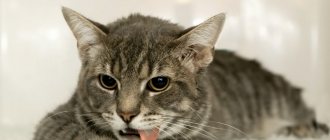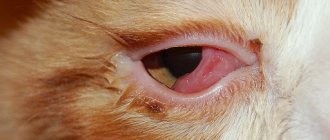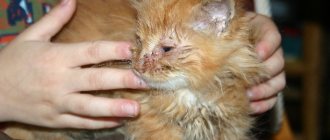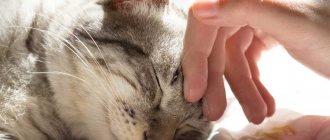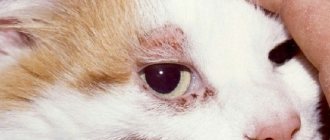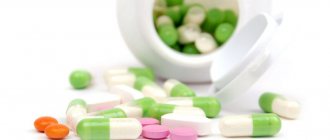Pet owners often experience that their domestic cat vomits undigested food after eating. This happened once, the cat feels normal, then vomiting is the body’s reaction to indigestion. If your pet is vomiting, the reason is not only banal overeating, but also serious disorders of the digestive tract. Such a deviation cannot be ignored. Observe the animal and you may need the help of a doctor.
Causes of vomiting that are not harmful to health
If vomiting happened once, we are talking about physiological functions of the body that are not dangerous for the pet. Occurs from overeating or rapid absorption of food. There are families with several pets. They compete with each other and try to swallow as much food as possible. The digestive system is not ready for such a volume and the cat regurgitates excess after eating.
Poor quality feed contains 3% meat and a small amount of protein. When consuming cheap feed, the amount of enzymes for digesting food is reduced, and food is not digested. This way the cat vomits after eating and cleanses the gastrointestinal tract. In addition to meat and protein, cheap food contains by-products and flavoring additives, which also cause vomiting.
If after vomiting the pet is cheerful and cheerful, there is no need to panic; the cause was overeating.
Why does a cat vomit after feeding?
If, after the next meal, the cat vomits dry food and has general weakness and apathy, you should not immediately run to the veterinarian. To begin with, you just need to find out the source of the problem and observe the actions of your pet. A cat may vomit food for many reasons.
Binge eating
Cats do not experience a pronounced feeling of fullness, so overeating is one of the most common reasons that causes nausea and vomiting. This happens if the owner does not follow the rules of feeding the pet and offers him a non-standard portion of food.
When dry food granules enter the stomach, they swell, cause discomfort, and contribute to severe pain. An excess can cause not only discomfort in the stomach, but also nausea or vomiting.
Hasty eating
Many cats are very interested in eating, regardless of their level of hunger and body needs. This is why rapid ingestion of dry food can clog the stomach and is often accompanied by vomiting and general weakness.
If your cat does not know how to control the speed of eating, and often vomits after dry food, you can prevent such consequences in the following ways:
- reduce the amount of food, divide the daily amount of dry food into 5-6 meals;
- use a special bowl with ridges that will automatically slow down rapid eating;
- create a comfortable environment for your pet, make sure that there are no other pets near him during meals.
Compliance with these rules will eliminate the risk of overeating and consequences such as vomiting in the kitten.
Abrupt change of feed
Changing food is always stressful for a cat, which manifests itself not only in the form of lack of appetite, but also in the occurrence of nausea. If a cat vomits from a new dry food, the following reasons may contribute to this:
- intolerance to components;
- poor quality product;
- stressful situation.
Such consequences can be avoided by following general recommendations regarding changing food. You need to switch to a new product within 1-2 weeks, while gradually adding new food to the standard diet.
Expired or low-quality food
If your cat vomits dry food immediately after eating, the cause may be the expiration date or poor quality of the product. When purchasing food, you must pay attention to the composition, the ratio of animal and plant components.
The more ingredients of animal origin it contains, the tastier and better quality the dry food will be.
Food intolerance
If after eating a cat begins to vomit, he loses his activity and experiences general weakness, this indicates a food intolerance to the product. This can also be confirmed by stool disorder.
Attention! Often the cause of vomiting is not the food itself, but a separate component in its composition. Often it is a source of protein.
Mixed feeding
The combination of dry food with other products often provokes nausea in a cat, causes general malaise, loss of appetite and other symptoms. This is due to different processes of food digestion.
For example, a combination of dry food with dairy products, which require a lot of resources to break down, can cause illness.
In order not to encounter such a manifestation, it is necessary to dilute the food in separate portions, and do not mix several products at one time.
Serious violations
- A common cause of indigestion is food poisoning of poor quality. The cat vomits all the time before and after eating, diarrhea appears, this speeds up the process of removing toxins from the body.
- Viruses and bacteria lead to the death of a pet. Therefore, a visit to the veterinarian is urgent.
- Food contaminated with chemicals or poisonous plants can cause indigestion. They are prepared for rats and mice, dangerous for pets.
If vomiting returns repeatedly, blood and mucus are noticed in the vomit, the cat vomits before and after eating, and becomes lethargic, what to do in this case. The answer is clear - you need to see a veterinarian and after finding out the reasons, drug treatment will be indicated.
What to do if your cat vomits undigested food
If a cat is vomiting from dry food, first you need to determine why this happened, and only then think about what to do in such a situation. A one-time adverse reaction rarely poses a visible threat to the kitten's health, but it is still a condition worth paying attention to. You can avoid such manifestations if you follow certain requirements:
- Feeding in small portions. Cats' stomachs are small, so they need a minimal amount of food to fully satiate.
- Checking the quality of food. You should not feed your cat dry food if its expiration date expired yesterday. One day of delay of a product can also lead to unforeseen consequences.
- Separate meals. Dry food is combined only with water; any other products, in particular dairy, can harm the stomach.
Only a correct and careful approach to organizing the cat’s nutrition will avoid serious complications.
Important! If high-quality food, separate feeding and control of overeating do not stop the vomiting, you should urgently contact a veterinarian. Often, regular vomiting of undigested food indicates serious disturbances in the functioning of the gastrointestinal tract.
Character of vomiting after eating
Vomiting is not a violation, but is a sign of cleansing the body of a physiological nature. Before taking action, look at the consistency and appearance of the vomit. If suspicious lumps are found in the contents, then you should immediately contact a veterinary clinic.
- Undigested food. Overfed or swallowed too quickly in large pieces. An isolated case is not a reason to visit a doctor. Constant, after eating - the functioning of the pancreas is disrupted.
- Pieces of wool. In long-haired breeds, vomiting can be caused by tyrchobezoars - hairballs. The pet licks itself and swallows fur, which accumulates in the stomach and causes discomfort. Large pieces irritate the stomach wall and make it difficult to digest food normally.
- Bile and foaming. The cat vomits food containing bile immediately after eating. Dysfunction of the gallbladder or liver is suspected. In some cases, white foam is present in the vomit.
Dry food may not be to blame
As you know, “after” does not mean “as a result”. And in our case, this also works: often the culprit of the problem is not the food at all.
Hairballs in the stomach
A common cause of vomiting not related to diet is hairballs (trichobezoars). When the stomach is empty, the cat may not feel any discomfort, but after a heavy meal, the stomach reacts with a spasm, trying to get rid of a foreign object that is interfering with normal digestion.
To dissolve hairballs in the gastrointestinal tract of cats, special malt pastes are used, available in pet stores and veterinary pharmacies. This prevention is especially relevant for cats of long-haired breeds.
Severe helminthic infestations
Did your cat vomit dry food for no particular reason? Try to remember the last time you gave him anthelmintic prophylaxis. If for a long time (recommended quarterly), it is possible that the culprit is parasites that have colonized not only the intestines, but also the esophagus, as well as other internal organs.
Please note that if the body is severely affected by worms, it is dangerous to remove them on your own, since there is a high risk of intoxication due to decay products. It is better to contact a veterinarian: he will draw up a treatment regimen that will not only destroy the parasites, but also smooth out the consequences of intoxication.
Infectious diseases and poisoning
Vomiting is not an independent disease, but only one of the symptoms of many conditions, some of which are quite harmless, while others are deadly. If your cat has vomited repeatedly, it is best to seek veterinary help. Urgent medical attention is required if:
- the cat vomits not only from dry food, but also from any other food or water;
- body temperature is increased or significantly decreased (normal 37.5–39 ° C);
- the pet looks lethargic, tries to hide, refuses games and communication.
Perhaps the cat has a serious viral infection or poisoning, which is why he is vomiting dry food. It is impossible to delay treatment in such a situation, since repeated vomiting threatens dehydration.
Diagnosis and treatment of the disease
A doctor's help will be needed if your pet is vomiting for more than one day or if it happens every day.
At the veterinary clinic, the cat will be diagnosed and monitored for health. The doctor will palpate the abdominal cavity. Palpation will reveal dense nodes and congestion. In addition, it is important for the doctor to find out in detail what the cat has been doing recently and its diet. If necessary, additional laboratory tests will be ordered. In rare cases, surgery will be required after diagnosis.
The doctor selects treatment based on the reasons. In case of poisoning, enterosorbents and a diet with plenty of fluids are prescribed. In case of parasitic infection, antihelminthic drugs are given. For problems with the gastrointestinal tract, antibiotics, anti-inflammatory drugs and enzymes are prescribed.
A cat regurgitates food: normal or pathological
Regurgitation of food is normal, but vomiting is pathological. Regurgitation occurs once or twice a day and not every day. The vomited material consists of food fragments or a white foamy mass. In this case, the pet is monitored and managed without the help of a veterinarian.
If attacks of vomiting occur 3 or more times a day or are repeated daily, this is a pathology that requires specialist intervention.
8.What happens to the sutures after removal.
After the tooth is removed, the surgeon places sutures on the wound surface. This promotes faster healing, reduced pain, less risk of inflammation, minimizes the risk of bleeding, and protects the blood clot from falling out.
At the SDent clinic we use the most modern and safe materials. The thread with which the surgeon sews the edges of the hole is self-absorbing. But during the process, the ends of the thread can cause discomfort to the patient and interfere with the oral cavity. Therefore, for the comfort and safety of the patient, the doctor always sets an appointment date for examination and removal of sutures in approximately 10 days.
1. A gauze swab on the hole. When can it be taken out?
As a rule, the doctor does not immediately release the patient after removal, but asks him to wait for 15-20 minutes within the clinic to then examine and make sure that everything is in order with blood clotting and the tampon can be removed without fear. In rare cases, keeping the tampon in your mouth may take 30-40 minutes, usually 10-20 minutes. There is no need to keep it longer and it is even dangerous, because bacteria accumulate on it and there is a possibility of infection. There are exceptions, when the wound continues to bleed a little, then the old tampon is replaced with a new sterile one and kept for some time.
For some time, saliva may still be pinkish due to staining with secreted ichor, this should not be alarming, this situation can be distinguished from bleeding. At this moment, saliva can be easily swallowed; there is no need to accumulate it in the mouth.
3.Applying ice.
After tooth extraction in our Center, a specialist will give you ice specially prepared for such procedures to apply in the first hours after extraction. Ice is applied for a certain time, at certain intervals, which the doctor will instruct you about. At home, this procedure will need to be continued for some time (the first few hours after removal). This is done in order to minimize or completely eliminate tissue swelling.
Under no circumstances should you heat the area in the area of the extracted tooth; in this case, suppuration will develop.
6. Medications after removal.
After the procedure, the doctor prescribes a number of medications to take. Under no circumstances should you take any medications on your own, without consulting a doctor.
Painkillers should be taken in case of pain, at intervals and in the amount recommended by the doctor. Each case is individual; it happens that the patient does without taking painkillers.
Antibiotics. In some cases, after removal, antibiotics are prescribed for 5-7 days. As a rule, these are situations when the doctor removes a tooth in the stage of inflammation, complex extraction or removal of several units of teeth. Only a specialist surgeon decides whether to take antibiotics or not.
Antihistamines. Reduces the likelihood of swelling.
Antiseptics. Used as a rinse. BUT, remembering that rinsing movements are prohibited in the first days. A small amount of solution is taken into the mouth and simply held in the mouth, then calmly spit out. Such baths must be done if the tooth was removed during the inflammation phase, if the flux was exposed, if there are teeth affected by caries in the oral cavity.
Burps food
Cats who eat only dry food often burp almost immediately after eating. When dry food mixes with the contents of the stomach, it expands and causes discomfort.
Something as harmless as a form of dry food can cause spit up. Try different forms of dry food to see if your kitten can handle pellet-shaped food versus star- or square-shaped kibble.
© shutterstock
After tooth extraction, you should not do the following.
- In the first couple of days, taking a hot bath is excluded, only a warm shower.
- During sleep, you need to be careful not to lie on the side where the tooth was removed, this provokes the appearance of swelling.
- Visiting the gym and active physical activity should be postponed in the first days.
- Do not touch the wound with your tongue or foreign object.
- Do not open your mouth very wide, do not use active chewing and facial movements to avoid the sutures coming apart.
- Aspirin is not suitable as an anesthetic due to the fact that it has a thinning effect on the blood and may cause bleeding and hematoma.
- Do not rinse during the first few days. This can negatively affect the loss of a blood clot from the socket and the occurrence of inflammation.
For more information and to make an appointment with a specialist, call:
+7,
How does a cat behave before vomiting?
Vomiting is usually preceded by nausea, which is expressed in the animal's restless behavior and erratic movement from place to place. Excessive salivation and licking are often observed. The cat constantly makes swallowing movements and sometimes begins to meow.
After a while, he begins to sharply clear his throat, and then tilts his head and pulls it forward. Breathing becomes deep and rapid. After this, contractions begin in the abdomen and throat. Vomiting occurs. What to do if vomiting is frequent?

